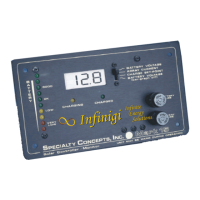INSTALLATION
WARNINGS
WARNING: Electricity, even low voltage electricity, can be dangerous. Installation should
be performed by a licensed electrical contractor or other qualified personnel only. The
requirements of the U.S. National Electrical Code should be followed.
WARNING: Follow all safety precautions of the battery manufacturer. Proper ventilation
must be provided for the batteries. Most batteries produce hydrogen gas when
charging, which is extremely explosive. Provide adequate battery ventilation. DO NOT
expose the battery to open flame, matches, cigarettes or sparks.
CAUTIONS: (The following can cause a fuse to blow and may damage the unit)
CAUTION: DO NOT EXCEED THE UNIT’S VOLTAGE AND CURRENT RATINGS:
• Do not exceed the maximum open circuit voltage (voc) rating of 26 volts. This is the
sum of the Voc of all solar panels in series.
• Do not exceed the maximum current rating of 15 amps (MARK/15) or 20 amps
(MARK/20). This is the sum of the short circuit currents (Isc) of all the solar panels in
parallel.
CAUTION: DO NOT DEVIATE FROM THE RECOMMENDED WIRING INSTRUCTIONS:
• Do not reverse Battery(+) and Battery(-) connections to the MARK/(15,20). Any
reverse polarity to the battery may damage the unit.
• Do not reverse the Battery and Solar Array connections to the MARK/(15,20). A
battery connected to the array terminals may damage the unit.
• Do not connect the array directly to the battery when the array is connected to the
MARK/(15,20) at the same time. This will cause the fuse to blow when the battery
reaches full charge voltage
• Do not wire the MARK/(15,20) in such a way that it can be connected to an
alternator (or other charging source) while the battery is disconnected. Other
charging sources should have independent connections to the battery.
• Do not wire the MARK/(15,20) in such a way that it can be connected to a load
without a battery connected. (Example: Do not connect the loads directly to the
MARK/(15,20) BATT terminals. This will damage the controller if the battery is
disconnected.)

